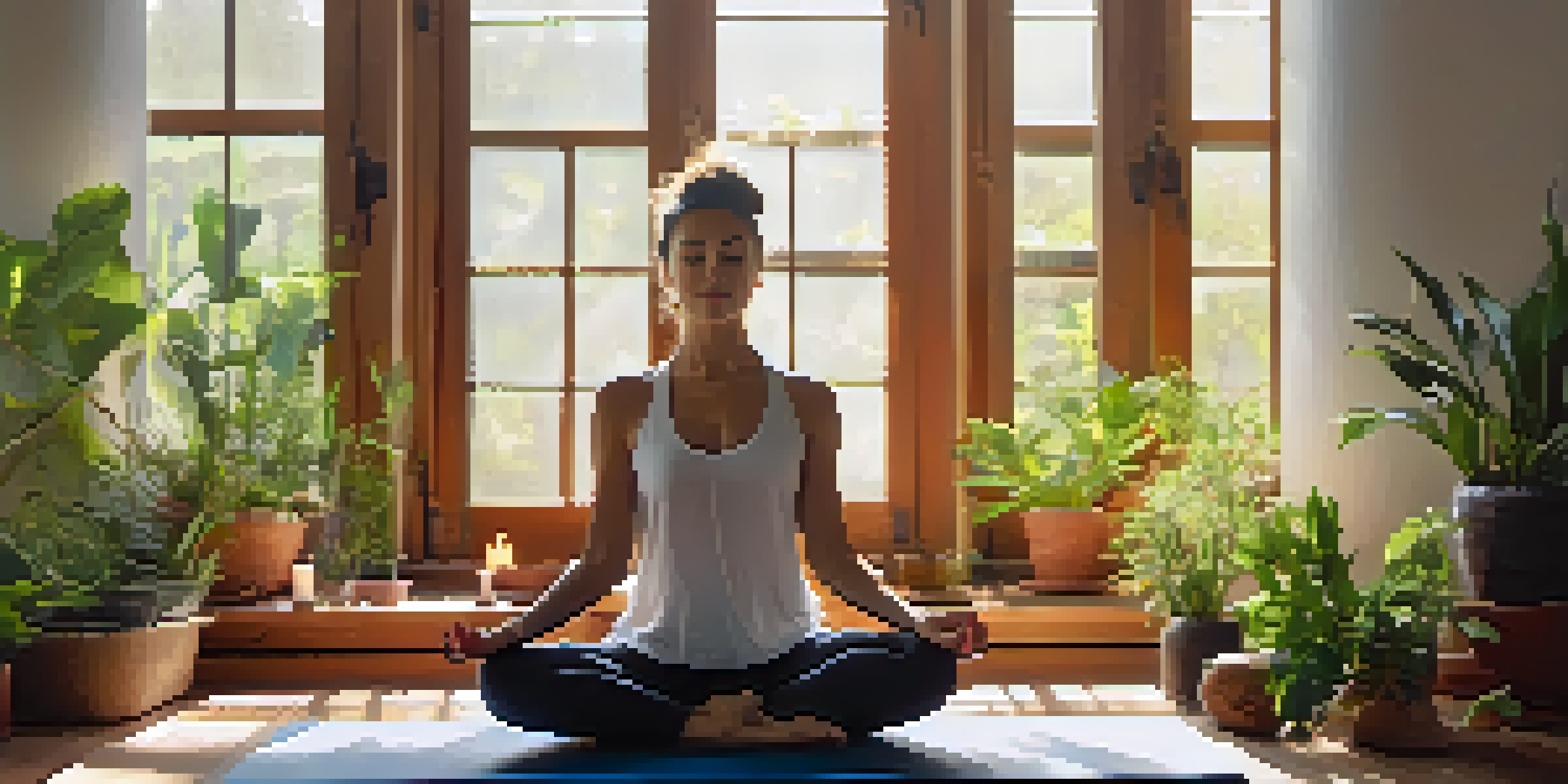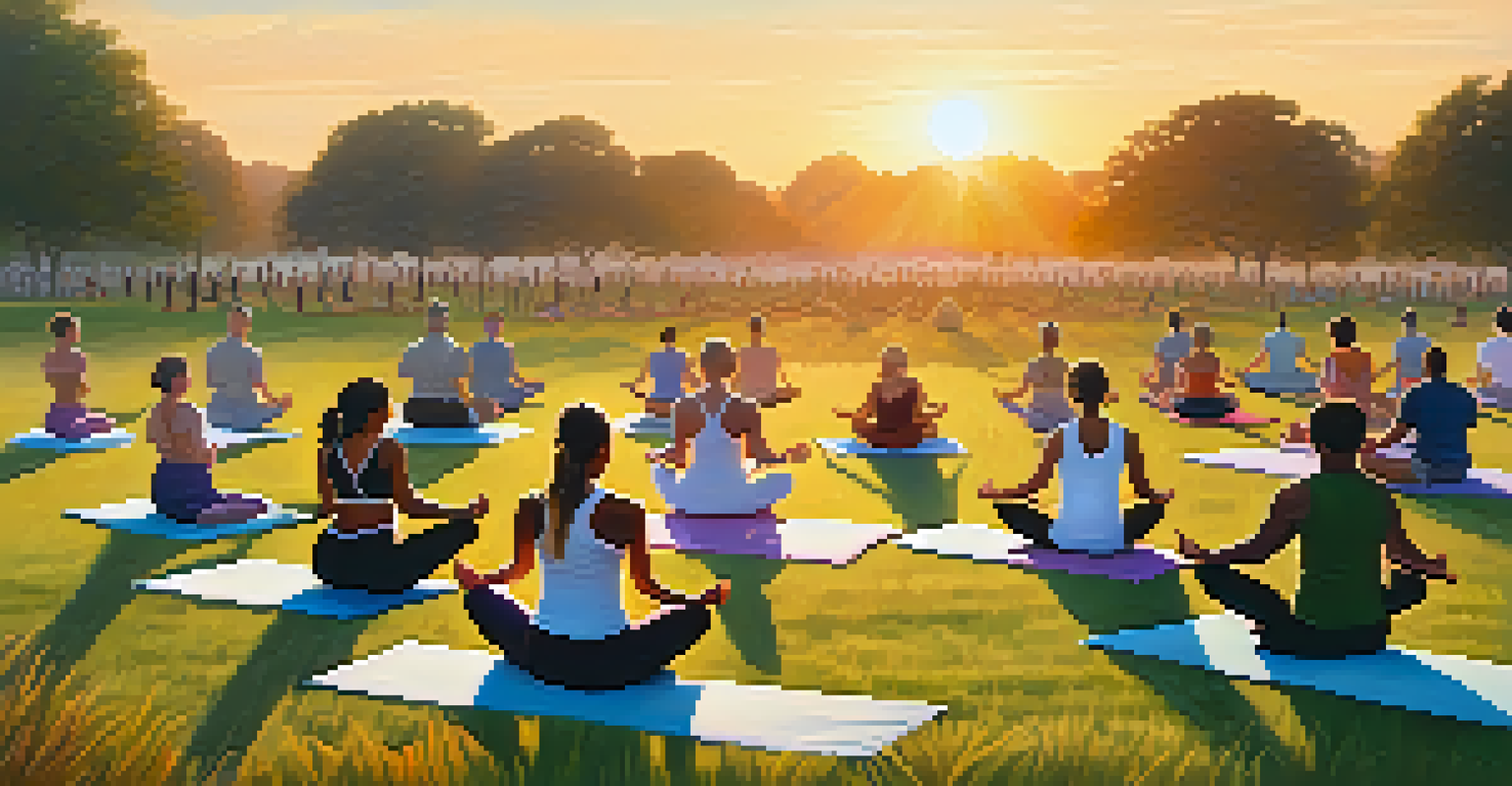Integrating Meditation Apps into Your Yoga Routine

Why Combine Meditation with Your Yoga Routine?
Meditation and yoga have long been partners in promoting wellness, both mentally and physically. Integrating meditation into your yoga practice can deepen your connection to the present moment, helping you cultivate mindfulness. This combination allows for a more holistic approach to your well-being, as you not only work on your body but also nurture your mind.
The mind is everything. What you think you become.
Moreover, meditation helps to enhance the benefits of yoga by encouraging relaxation and focus. When you meditate before or after your yoga session, you create a serene mental space that can make your physical practice more effective. Think of it as setting the stage for a beautiful performance; meditation allows you to be fully present and engaged.
Ultimately, the synergy between meditation and yoga can lead to a more fulfilling practice. By embracing both elements, you're not just moving through poses; you're fostering a deeper awareness of your body and breath, which can enhance every aspect of your life.
Choosing the Right Meditation App for You
With a plethora of meditation apps available, finding the right one can feel overwhelming. Start by considering your goals: Are you looking to reduce anxiety, improve focus, or enhance your mindfulness during yoga? Apps like Headspace or Calm offer guided meditations tailored to various needs, making it easier for you to start.

Additionally, look for features that resonate with your personal style. Some apps provide short, bite-sized sessions perfect for a quick five-minute break before yoga, while others might offer longer, more in-depth practices. This variety allows you to integrate meditation seamlessly into your routine, no matter how much time you have.
Meditation Enhances Yoga Practice
Integrating meditation into your yoga routine deepens mindfulness and enhances the overall effectiveness of your physical practice.
Remember, the best app is one that feels right for you. Take advantage of free trials to explore different options, and trust your intuition to guide you toward a choice that complements your yoga journey.
Creating a Mindful Space for Meditation
Just like your yoga mat, your meditation space matters. Creating a dedicated area can help signal to your brain that it’s time to pause and reflect. Choose a quiet spot in your home that feels comfortable, and consider adding calming elements like candles, cushions, or even plants to enhance the ambiance.
Yoga is the journey of the self, through the self, to the self.
This space doesn’t have to be elaborate; simplicity often works best. A clean, clutter-free area can help minimize distractions, allowing you to focus on your breath and thoughts. Think of it as your personal sanctuary where you can retreat from the busyness of life.
By establishing a mindful space, you set the tone for both your meditation and yoga practices. It's a gentle reminder to slow down and reconnect with yourself, which can profoundly impact your overall experience.
Incorporating Meditation into Your Yoga Sessions
Integrating meditation into your yoga practice can be as simple as setting aside a few minutes before or after your session. Begin or end with a short meditation to ground yourself, focusing on your breath as you take a few deep inhales and exhales. This practice can help clear your mind, making your yoga flow more intentional.
You can also explore guided meditations that align with your yoga practice. Some apps offer specific sessions designed to enhance flexibility or focus on mindfulness, which can be beneficial when holding poses. Imagine practicing tree pose while listening to a meditation that encourages stability and grounding—it's a powerful combination.
Create a Dedicated Meditation Space
Establishing a quiet, clutter-free area for meditation signals to your mind that it’s time to focus and reflect.
Ultimately, the key is to listen to your body and mind. Feel free to adjust the timing and type of meditation based on how you’re feeling that day. This flexibility allows your practice to evolve, making it more enriching over time.
Using Guided Meditations for Deeper Connection
Guided meditations can serve as an excellent tool for deepening your yoga practice. By following along with a meditation instructor, you can better focus on your breathing and the sensations in your body. This external guidance can be especially helpful for beginners who are still learning how to connect their breath with movement.
Many meditation apps provide themed guided sessions that relate directly to your yoga practice. For instance, a session focused on gratitude can enhance your experience in heart-opening poses like camel or cobra. This alignment creates a richer experience, as you’re actively engaging both your mind and body.
As you become more comfortable, you might find you prefer to meditate without guidance. However, starting with guided sessions can help establish a strong foundation, making your eventual transition to solo meditation smoother and more rewarding.
Tracking Your Progress with Meditation Apps
Many meditation apps come equipped with tracking features that help you monitor your progress. These tools can provide insights into your consistency, duration of sessions, and even your mood over time. Tracking can be particularly motivating, as it allows you to see how your practice evolves.
As you integrate meditation into your yoga routine, consider setting specific goals. Whether it’s meditating for a certain number of days in a row or completing a series of guided sessions, having objectives can boost your commitment. The satisfaction of achieving these milestones can be incredibly rewarding.
Flexibility is Key in Your Journey
Embracing flexibility in your meditation and yoga practice allows for a more compassionate approach to your personal well-being.
Moreover, reflecting on your progress can enhance your self-awareness. By understanding how meditation impacts your yoga practice and daily life, you can make informed adjustments to your routine, ultimately leading to a more fulfilling experience.
Embracing Flexibility in Your Practice
One of the beautiful aspects of integrating meditation into your yoga routine is the flexibility it allows. Everyone’s journey is unique, and some days you may feel more inclined to focus on meditation rather than physical poses. Embracing this adaptability can help you cultivate a more compassionate relationship with yourself.
It’s important to recognize that yoga and meditation are not rigid practices; they can evolve based on your needs and circumstances. If you find yourself feeling particularly stressed, you might prioritize a longer meditation session over an intense yoga workout. This shift can provide the relief you need, reminding you to listen to your body.

Ultimately, the goal is to create a practice that serves you best. By allowing yourself the freedom to explore various approaches, you’ll discover what resonates most and fosters a deeper connection to both your mind and body.